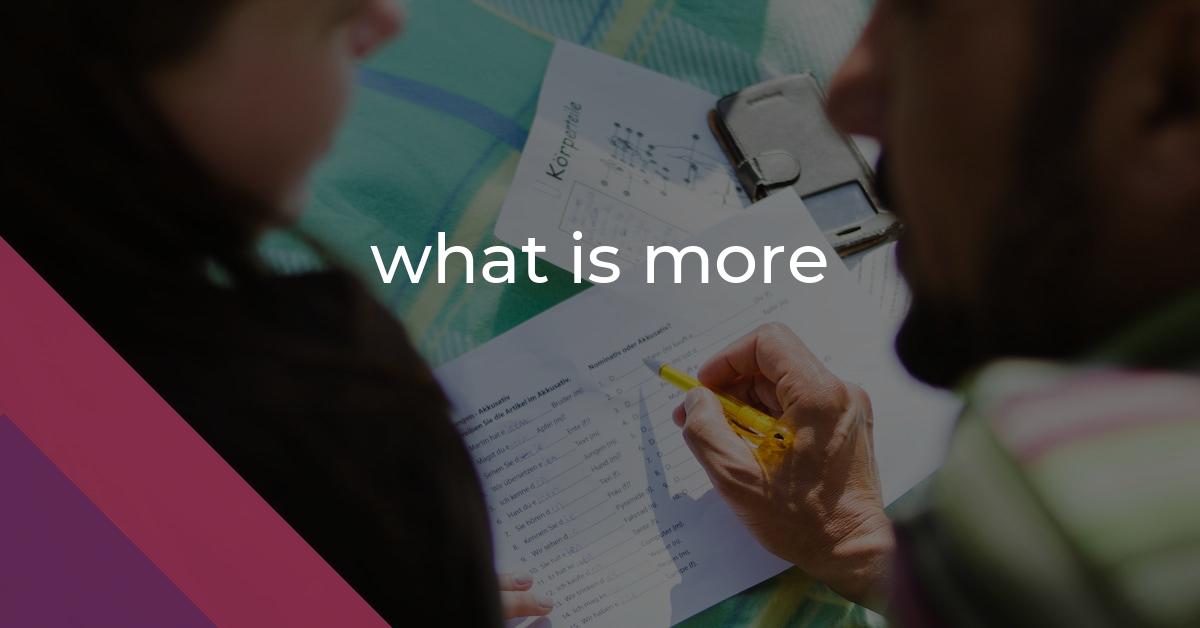what is more: Idiom Meaning and Origin
What does ‘what is more’ mean?
The idiom "what is more" is used to introduce an additional and often more important point or piece of information in a conversation or argument.

Idiom Explorer
The idiom "you know what" is used as a phrase that often indicates that the speaker is trying to avoid saying something explicitly, assuming the listener already knows or will understand the unspoken message.
The idiom "what's what" means to understand or know the important or essential information about a subject or situation.
The idiom "what's the difference" is used to express indifference or to question the importance or significance between two choices or options.
The idiom "what's new" is used as a casual way of asking for the latest or most recent information or updates about someone or something.
The idiom "what's going on" is used to inquire about the current situation or events, seeking information or understanding. It's a casual expression commonly used in conversations to ask about what is happening or to express confusion.
The idiom "the reality is" is used to emphasize that a certain statement or fact is true, regardless of any other opinions or beliefs.
The idiom "that's the thing" is used to emphasize a crucial point or argument in a discussion or conversation.
The idiom "that's saying something" is used to highlight a statement that is particularly noteworthy or impressive, often because it exceeds expectations or goes against common assumptions.
The idiom "or what" is used as a rhetorical question to emphasize a statement or assertion that is strongly believed or supported. It is often used to express certainty, determination, or defiance. The phrase is typically used in informal or spoken language.
Unpacking Further
The idiom "what is more" is a commonly used phrase in the English language. It is used to introduce information of greater importance or significance than what has just been mentioned. The phrase adds emphasis to a point or provides additional evidence or support for a claim.
When used in conversation or writing, "what is more" is typically followed by a noun or a noun phrase. This clarifies the specific addition or point being made. For example, someone might say, "She not only completed all her work on time, but what is more, she also volunteered to help others with their projects."
The idiom "what is more" can be seen as a variation of the phrase "what's more," and the two are often used interchangeably. The phrase can be traced back to Middle English, where it was used to express an added or more important point. Over time, the expression evolved into the commonly used idiom we know today.
Furthermore, "what is more" is an idiom that is understood by native English speakers and is not usually considered to be overly formal or outdated. Its usage is commonplace and widely accepted in both spoken and written English.
The idiom "what is more" serves as a powerful tool in the English language to emphasize an important point or add additional support to an argument. Its historical origins can be traced back to Middle English, and it has since become a versatile and widely used expression. The continued use and recognition of this idiom reflect its enduring relevance in the English language, making it an indispensable part of our linguistic repertoire.
in addition to "what is more," there are several related idioms that convey similar ideas or serve similar functions.
"In addition" is an idiomatic phrase that is often used to introduce extra information or to provide further examples. It can be used in a similar way to "what is more" to add emphasis or to expand upon a previous point. For example, "She completed all her work on time. In addition, she volunteered to help others with their projects."
The idiom "what's what" is another expression that can be used to introduce important or essential information. It can be seen as a synonym for "what is more" in certain contexts. For instance, "He not only knows the basics of coding, but he also understands the nuances of programming languages. That's what's what."
"the thing is" is an idiomatic phrase that is often used to introduce an important or crucial point in a conversation or argument. It can be used interchangeably with "what is more" to emphasize a particular aspect or to provide additional clarity. For example, "He completed all his tasks on time. The thing is, he also exceeded expectations by delivering high-quality results."
"what's the difference" is a common idiom that is used to explore or highlight distinctions between two or more things. While it may not be used in the exact same way as "what is more," it shares the goal of adding information or expanding upon a previous idea. For example, "She not only has a graduate degree, but she also has practical work experience. So, what's the difference? She's well-equipped for the job."
"that's the thing" is a colloquial expression that is often used to introduce an important or critical point. It can also function similarly to "what is more" in certain contexts. For instance, "He not only has the skills for the job, but he also has the right attitude. That's the thing we're looking for."
Example usage
Examples of how the idiom "what is more" can be used in a sentence:
- He is incredibly talented, and what is more, he's always willing to help others.
- She not only excels in academics but what is more, she is a skilled athlete.
- The hotel has a beautiful swimming pool, and what is more, it offers stunning views of the ocean.
More "Comparisons" idioms



